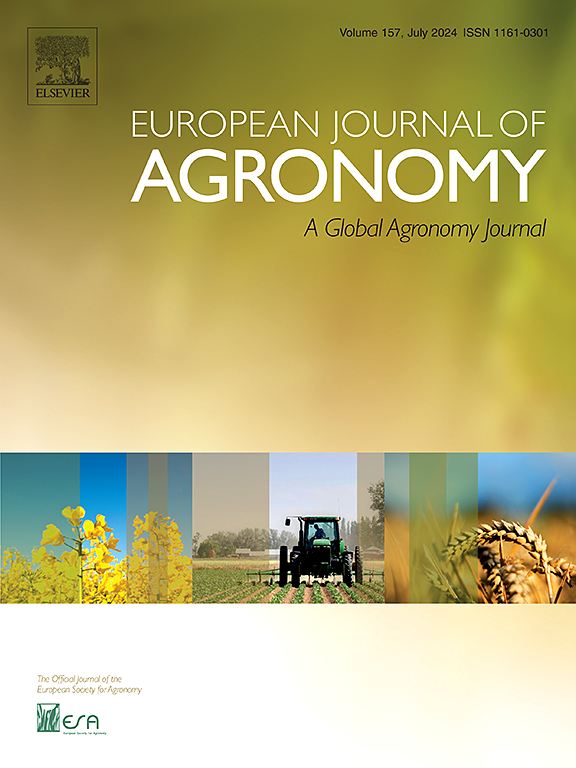不同水资源管理方式下不同玉米杂交种的表现及其相应的耗水分析——基于TOPSIS方法的雨棚试验的启示
IF 4.5
1区 农林科学
Q1 AGRONOMY
引用次数: 0
摘要
杂交选择和水分管理措施对维持玉米产量至关重要。采用短季杂交种是促进华北平原玉米生产的可行策略。然而,关于该地区SS的粮食产量和耗水特性的信息有限。采用SS和全季杂交种(FS)在雨棚下进行了为期3年的试验。玉米植株在3个灌溉量下生长(目标土壤相对含水量分别为60% (WL)、75% % (WM)和90% (WH))。结果表明,FS的水分利用效率比SS高6.7 %,SS的水分利用效率与FS相当甚至更高。土壤蒸发量(E)和作物蒸散量(ET)分别比FS降低了7. %和9.5%。灌溉水平越高,三个生长季节的日耗水强度越高。GY与ET的关系拟合为二次函数。土壤E / ET与叶面积指数呈对数关系。夏玉米土壤E和ET随灌溉水量的增加而增加。与WH相比,WM的产量和氮肥偏要素生产率(NPFP)具有统计学差异(p >; 0.05)。TOPSIS (Order Preference Technique for Order Preference by Similarity to Ideal Solution)方法显示,FSWM处理排名第一,其次是SSWM处理。WM是两个杂交种保持产量、提高效率和优化耗水特性的适宜灌溉水平。本研究为玉米产量和耗水特性与杂交成熟度和水分管理措施的关系提供了科学的见解。本文章由计算机程序翻译,如有差异,请以英文原文为准。
Performance of different corn hybrids and their corresponding water consumption analysis under various water management practices: Insights from experiments conducted under rain-shelters based on the TOPSIS method
Hybrid selection and water management practices are crucial for sustaining corn productivity. The adoption of short-season hybrid (SS) represents the viable strategy to facilitate corn production in the North China Plain. However, there is limited information available regarding grain yield (GY) and water consumption characteristics for SS in this region. The three-year experiment was carried out under the rain-shelters with SS and full-season hybrid (FS). Corn plants were grown under three irrigation amounts (target relative soil moisture content was at 60% (WL), 75 % (WM), and 90% (WH) of field capacity). The results showed the GY for FS was 6.7 % higher than that for SS, SS obtained comparable or even higher water use efficiency (WUE) than FS. Soil evaporation (E) and crop evapotranspiration (ET) for SS were decreased by 7.2 % and 9.5%, compared with those for FS. The higher irrigation level resulted on the higher the intensity of daily water consumption during three growing seasons. The relationship between GY and ET was fitted to the quadratic function. A logarithmic relationship was observed between the ratio of soil E to ET and the leaf area index. The soil E and ET of summer corn demonstrated an increase with the augmentation of applied irrigation water. WM had statistically similar (p > 0.05) yield and N fertilizer partial factor productivity (NPFP) compared to WH. The TOPSIS (Technique for Order Preference by Similarity to Ideal Solution) method showed the FSWM treatment ranked first, followed by SSWM treatment. WM was the appropriate irrigation level for both hybrids to maintain yields, improve efficiency and optimize water consumption characteristics. This study provided scientific insights into corn yield and water consumption characteristics in relation to hybrid maturity and water management practices.
求助全文
通过发布文献求助,成功后即可免费获取论文全文。
去求助
来源期刊

European Journal of Agronomy
农林科学-农艺学
CiteScore
8.30
自引率
7.70%
发文量
187
审稿时长
4.5 months
期刊介绍:
The European Journal of Agronomy, the official journal of the European Society for Agronomy, publishes original research papers reporting experimental and theoretical contributions to field-based agronomy and crop science. The journal will consider research at the field level for agricultural, horticultural and tree crops, that uses comprehensive and explanatory approaches. The EJA covers the following topics:
crop physiology
crop production and management including irrigation, fertilization and soil management
agroclimatology and modelling
plant-soil relationships
crop quality and post-harvest physiology
farming and cropping systems
agroecosystems and the environment
crop-weed interactions and management
organic farming
horticultural crops
papers from the European Society for Agronomy bi-annual meetings
In determining the suitability of submitted articles for publication, particular scrutiny is placed on the degree of novelty and significance of the research and the extent to which it adds to existing knowledge in agronomy.
 求助内容:
求助内容: 应助结果提醒方式:
应助结果提醒方式:


